


Brannam Pottery was a British pottery started by Thomas Backway Brannam in Barnstaple, Devon, England, in 1848. It later became part of the "rustic" wing of the art pottery movement.



Brannam Pottery was a British pottery started by Thomas Backway Brannam in Barnstaple, Devon, England, in 1848. It later became part of the "rustic" wing of the art pottery movement.
Thomas Brannam took over the lease of an existing pottery at North Walk, and another in Litchdon Street, Barnstaple. [1] Like other pottery firms of the time, the firm originally made utilitarian wares such as basic household items, floor tiles, bricks and sewage pipes. This was their "bread and butter" trade, although one of their decorative jugs secured a medal at the Great Exhibition in 1851.
In 1867 Thomas's son, Charles Hubert Brannam, left school at age 12 to start work at the pottery. Charles won a prize for art at school and also won the Queen's Prize for Drawing in 1870. [2] Initially educated in the theory and practice of ceramics, he was encouraged by a local dignitary, William Frederick Rock, who invited him to London where he studied pottery in the various museums. In 1879 he persuaded his father to allow him to produce art ware. His father agreed on the proviso that Charles paid for the materials he used.
Charles eventually took over the Litchdon Street pottery and further developed the art pottery department, utilising the "sgraffito" technique of scratching into a covering of "slip" to show the clay beneath. He recruited skilled designers, but also continued to throw the ware himself. In 1885 he received an order from Queen Victoria which resulted in excellent publicity for the business. In 1886 Charles registered the name Royal Barum Ware and ensured it was sold by several London firms including Liberty.
Charles handed the business over to his sons, Charles William Brannam, and John Woolacott (Jack) Brannam, in 1913. In 1914 C.H. Brannam and Sons became a limited liability company. Jack's son, Peter, carried out considerable modernization in the post-war period, but when he retired in 1979 he sold the business to Candy Tiles of Newton Abbot. They found the old Litchdon Street premises too cramped for their operation, and in 1989 moved the company to a site on the Roundswell Industrial Estate. Despite the fact that no member of the family was still connected with it, it was still called "C.H.Brannam & Sons Ltd". It ceased operations in 2005.
The original premises in Litchdon Street partly survive now with their terracotta detailing and stained glass with a preserved kiln still visible in the car park of a medical practice. These premises are now Grade II listed. [3]
The company has used many marks over the years including C H Brannam, Barum, and Barnstaple.
The company's collection of ceramic works was purchased by the Museum of Barnstaple and North Devon with the help of the Art Fund. [4]
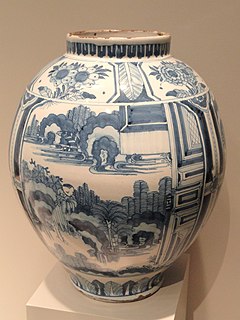
Delftware or Delft pottery, also known as Delft Blue or as delf, is a general term now used for Dutch tin-glazed earthenware, a form of faience. Most of it is blue and white pottery, and the city of Delft in the Netherlands was the major centre of production, but the term covers wares with other colours, and made elsewhere. It is also used for similar pottery, English delftware.

Studio pottery is pottery made by professional and amateur artists or artisans working alone or in small groups, making unique items or short runs. Typically, all stages of manufacture are carried out by the artists themselves. Studio pottery includes functional wares such as tableware and cookware, and non-functional wares such as sculpture, with vases and bowls covering the middle ground, often being used only for display. Studio potters can be referred to as ceramic artists, ceramists, ceramicists or as an artist who uses clay as a medium.

Wedgwood is an English fine china, porcelain and luxury accessories manufacturer that was founded on 1 May 1759 by the potter and entrepreneur Josiah Wedgwood and was first incorporated in 1895 as Josiah Wedgwood and Sons Ltd. It was rapidly successful and was soon one of the largest manufacturers of Staffordshire pottery, "a firm that has done more to spread the knowledge and enhance the reputation of British ceramic art than any other manufacturer", exporting across Europe as far as Russia, and to the Americas. It was especially successful at producing fine earthenware and stoneware that were accepted as equivalent in quality to porcelain but were considerably cheaper.

Royal Doulton is an English ceramic and home accessories manufacturer that was founded in 1815. Operating originally in Vauxhall, London, and later moving to Lambeth, in 1882 it opened a factory in Burslem, Stoke-on-Trent, in the centre of English pottery. From the start, the backbone of the business was a wide range of utilitarian wares, mostly stonewares, including storage jars, tankards and the like, and later extending to pipes for drains, lavatories and other bathroom ceramics. From 1853 to 1901, its wares were marked Doulton & Co., then from 1901, when a royal warrant was given, Royal Doulton.
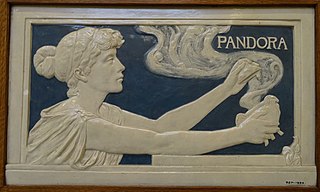
The Della Robbia Pottery was a ceramic factory founded in 1894 in Birkenhead, near Liverpool, England. It closed in 1906. Initially it mostly made large pieces with high artistic aspirations, especially relief panels for architectural use, but also ornamental vessels and plates, intended for display rather than use.

Mintons was a major company in Staffordshire pottery, "Europe's leading ceramic factory during the Victorian era", an independent business from 1793 to 1968. It was a leader in ceramic design, working in a number of different ceramic bodies, decorative techniques, and "a glorious pot-pourri of styles - Rococo shapes with Oriental motifs, Classical shapes with Medieval designs and Art Nouveau borders were among the many wonderful concoctions". As well as pottery vessels and sculptures, the firm was a leading manufacturer of tiles and other architectural ceramics, producing work for both the Houses of Parliament and United States Capitol.
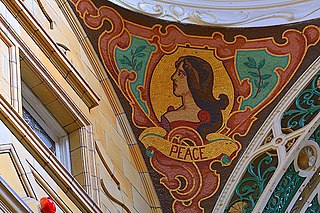
Burmantofts Pottery was the common trading name of a manufacturer of ceramic pipes and construction materials, named after the Burmantofts district of Leeds, England.

Villeroy & Boch is a German manufacturer of ceramics, with the company headquarters located in Mettlach, Saarland.
Fielding majolica is pottery made at the Railway Pottery in Stoke on Trent under the proprietorship of Simon Fielding (1827–1906) and Abraham Fielding. Victorian majolica is a generic name given to the brightly coloured lead-glazed earthenware that was originally developed by Mintons for the Great Exhibition of 1851.

Victorian majolica properly refers to two types of majolica made in the second half of the 19th century in Europe and America.

Farnham Pottery is located in Wrecclesham near Farnham, Surrey. This is one of the best preserved examples of a working Victorian country pottery left in England and is a grade II listed building. Its significance in the local area is shown by it featuring on the emblem of Wrecclesham Cricket Club.
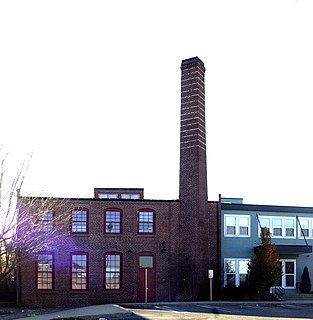
Dorchester Pottery Works is a historic site at 101-105 Victory Road in Dorchester, Massachusetts, a neighborhood of Boston. The Dorchester Pottery Works was founded in 1895 by George Henderson and made stoneware. The Dorchester Pottery Works closed in 1979. The building was designated as a Boston Landmark in 1980 and added to the National Register of Historic Places in 1985.

Svend Bayer is a Danish-British studio potter described by Michael Cardew as "easily my best pupil."
Edwin Bennett, born in Newhall, Derbyshire, was an English American pioneer of the pottery industry and art in the United States, and founder of the Edwin Bennett Pottery Company of Baltimore, Maryland. Producing a variety of wares from the everyday to the fine and artistic, his company, originally founded in the 1840s as the Edwin Bennett Queensware Manufactory, continued in operation until forced to close during the Great Depression in 1936. Examples of Edwin Bennett pottery may be found in museums across the United States, including the Maryland Historical Society, the Philadelphia Museum of Art, the Metropolitan Museum of Art, and the National Museum of American History, as well as in private collections.
Clive Bowen is a Devon based potter whose work is included in a number of public collections.

Franciscan Ceramics are ceramic tableware and tile products produced by Gladding, McBean & Co. in Los Angeles, California, from 1934 to 1962, International Pipe and Ceramics (Interpace) from 1962 to 1979, and Wedgwood from 1979 to 1983. Wedgwood closed the Los Angeles plant, and moved the production of dinnerware to England in 1983. Waterford Glass Group plc purchased Wedgwood in 1986, becoming Waterford Wedgwood. KPS Capital Partners acquired all of the holdings of Waterford Wedgwood in 2009. The Franciscan brand became part of a group of companies known as WWRD, an acronym for "Wedgwood Waterford Royal Doulton." WWRD continues to produce the Franciscan patterns Desert Rose and Apple.
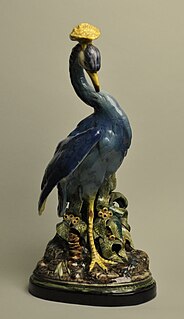
California pottery includes industrial, commercial, and decorative pottery produced in the Northern California and Southern California regions of the U.S. state of California. Production includes brick, sewer pipe, architectural terra cotta, tile, garden ware, tableware, kitchenware, art ware, figurines, giftware, and ceramics for industrial use. Ceramics include terra cotta, earthenware, porcelain, and stoneware products.
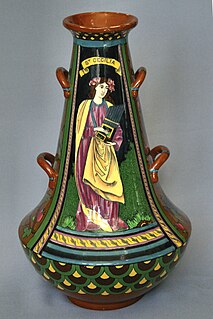
Shelley Potteries, situated in Staffordshire, was earlier known as Wileman & Co. which had also traded as The Foley Potteries. The first Shelley to join the company was Joseph Ball Shelley in 1862 and in 1896 his son Percy Shelley became the sole proprietor, after which it remained a Shelley family business until 1966 when it was taken over by Allied English Potteries. Its china and earthenware products were many and varied although the major output was table ware. In the late Victorian period the Art Nouveau style pottery and Intarsio ranges designed by art director Frederick Alfred Rhead were extremely popular but Shelley is probably best known for its fine bone china “Art Deco” ware of the inter-war years and post-war fashionable tea ware.

The Bovey Tracey Potteries were a collection of potteries in the Bovey Tracey area of Devon, based on the clay from the Bovey Basin. Pottery making developed in the area developed on an industrial scale from around 1750 and lasted for around 200 years under various owners and names.
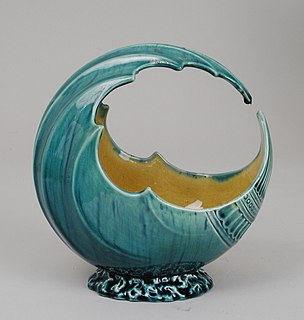
Linthorpe Art Pottery was a British pottery that operated between 1878 and 1890 in Linthorpe, Middlesbrough. It produced art pottery, and is especially known for the early collaboration of the designer Christopher Dresser; many of the early wares have his impressed signature.